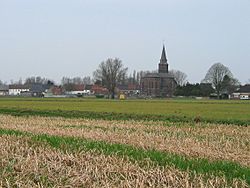Bernissart facts for kids
Quick facts for kids
Bernissart
Bernissåt (Picard)
|
|||
|---|---|---|---|
 |
|||
|
|||
| Country | Belgium | ||
| Community | French Community | ||
| Region | Wallonia | ||
| Province | Hainaut | ||
| Arrondissement | Ath | ||
| Area | |||
| • Total | 43.42 km2 (16.76 sq mi) | ||
| Population
(2018-01-01)Lua error in Module:Wd at line 1575: attempt to index field 'wikibase' (a nil value).
|
|||
| • Total | Lua error in Module:Wd at line 1,575: attempt to index field 'wikibase' (a nil value). | ||
| Postal codes |
7320-7322
|
||
| Area codes | 069 | ||
| Website | www.bernissart.be | ||
Bernissart (pronounced "bair-nee-sar") is a small town in Belgium. It is located in the province of Hainaut, which is part of Wallonia. A municipality is like a local government area.
As of January 1, 2006, Bernissart had a population of 11,458 people. The total area of the municipality is about 43.42 square kilometers. This means there were about 264 people living in each square kilometer.
The municipality of Bernissart includes several smaller areas. These areas are Blaton, Bernissart itself, Harchies, Pommerœul, and Ville-Pommerœul.
Contents
Discovering Ancient Dinosaurs
Bernissart is famous for an amazing discovery made long ago. In 1878, many Iguanodon dinosaur skeletons were found. They were deep inside a coal mine, about 322 meters (1,056 feet) underground.
The Iguanodon Herd
Finding so many skeletons close together was very important. At the time, it helped scientists realize that some dinosaurs lived in groups. This means they were "herd animals," just like elephants or zebras today.
How Skeletons Were Assembled
A scientist named Louis Dollo carefully put these skeletons together. His method for assembling them became the standard way for over 100 years. Nine of the twenty-nine skeletons found are now at the Royal Belgian Institute of Natural Sciences. One more is at the Bernissart Museum.
Interestingly, the museums first displayed the Iguanodon skeletons standing upright. This made them look like they walked on two legs (bipedal). But scientists later learned that Iguanodon usually walked on all four legs. The museums now humorously admit this early mistake.
Other Fossils Found
Along with the Iguanodon skeletons, other ancient remains were found. These included fossilized plants, fish, and other reptiles. One of these reptiles was a type of ancient crocodile called Bernissartia. The rocks where these fossils were found are part of the Sainte-Barbe Clays Formation.
See also
 In Spanish: Bernissart para niños
In Spanish: Bernissart para niños





